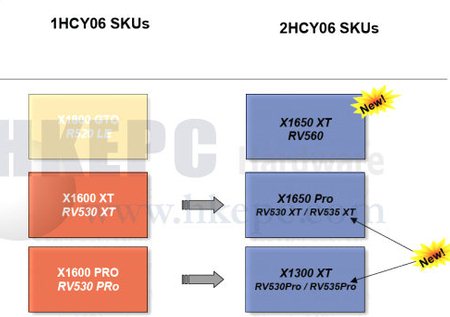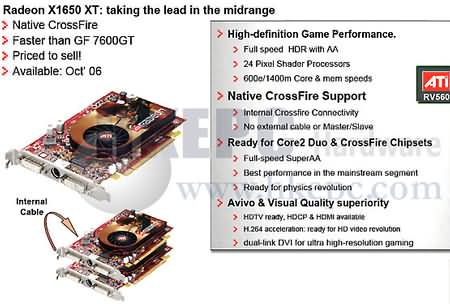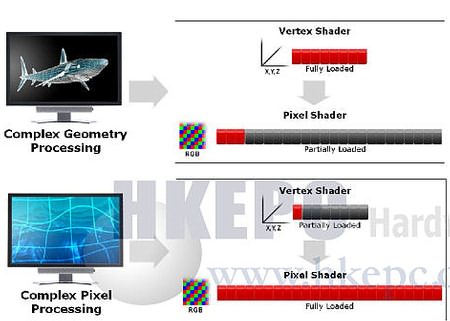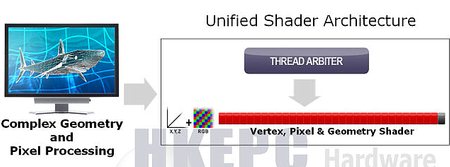 |
||
|
||
| ||
ATI To Release X1650 To Compete With G73 ATI On DirectX 10: Unified Shading Architecture, Near-Future Graphics Technologies Intel And Micron Sample First 50-Nanometer NAND Flash Memory Devices ATI To Release X1650 To Compete With G73 Since nVidia released Geforce 7600 family (G73) in match, its corresponding rival Radeon X1600 was facing a strong enemy with lower cost and better performance, forcing ATi to recall a weakened R520 version Radeon X1800GTO (R520LE) for the level. In long term, ATi is going to release new Radeon X1650 family.  Radeon X1650 is composed by RV560, RV530 and RV535 chipset, where RV560 is correspond to the top model 1650XT. They are manufactured by TSMC with 80nm process, featured 8 Pixel Shader Pipelines, 24 Pixel Shader Processors (12 for RV530), 128Bit memory controller with 1.4GHz DDR support, 600MHz clock speed and build-in Compositing CrossFire Engine. It is no more master/salve card for CrossFire. Expected to be available in October, its price is set between $149 and $199.  After the launch of Radeon X1650XT, source hinted that Radeon X1600XT and Radeon X1600Pro would be renamed as Radeon X1650Pro and Radeon X1300XT with no any change in specification. Besides, the 80nm version of RV530 is available in October, codenamed RV535 and manufactured by TSMC. With a lower cost, ATi would definitely become more compatible. Radeon X1650 Pro is expected in $99 to $119, while Radeon X1300XT is expected in $79 to $99. Source: HKEPC
ATI On DirectX 10: Unified Shading Architecture, Near-Future Graphics Technologies Our colleagues from HKEPC interviewed ATI's Chipset Director Stan Ossias. The topic was API DirectX 10 and Unified Shading Architecture that will be used in graphics cards and 3D applications in the near future.  DirectX 9 and today’s hardware impose a number of unique constraints on game developers. Every character, weapon, material, etc. in a game is an object, and each frame of a 3D game, there can be hundreds of objects. Object have to pass from the application, to the DirectX 9 API, through to the driver, which prepares the data in order for the hardware to process it and output a 3D image to a monitor. Every time an object is passed through the API, DirectX adds overhead which consists of instructions and setting for the driver. The more is the object, the more is the overhead that needs to be processed. The additional overhead can mean a hit on performance. As a result, developers have to be very creative in how they use objects in order to keep the game playing at a satisfactory rate. Stan indicates that games in today use execution time being divided between 40% for the API and driver, and 60% for the game itself. DirectX 10 is designed to reduce much of the overhead by introducing Dynamic indexing state and loading state snapshots automatically. Thus the game itself could now spare 80% of the procession, allowing developers to put more objects into their games to make it more realistic.  Featured Shader Model 4.0, DirectX 10 provides 32-bit color depth unified pixel rendering to satisfy any range of game design. Besides, DirectX 10 enables developers to handle physics calculation and audio part more easily. It also benefits to CAD/CAM and special effect designers!  In order to fully squeeze the power, Stan indicated that the next generation of graphic card would introduce unified shading architecture. For traditional GPU, Vertex Shader and Pixel Shader processing are dedicated by different engines. Figure below show an example of the utilization of two different engines in processing. It’s possible that Vertex Shader is only partially loaded while Pixel Shader is fully loaded, and vice versa. In DirectX 10, they are further separated into Vertex Shader, Geometry Shader, and Pixel Shader. The Unified Shader architecture is therefore recommended by Microsoft to execute vertex, geometry and pixel in the same engine, maximizing shader performance efficiencies.  The concept of Unified Shader architecture makes GPU’s role moving from game rendering to game computing. It’s suitable for Heterogeneous Computing like Physics calculation, video encoding, etc., making graphic card be more applicable in different field of applications.  Games are being developed today for ATI’s Unified Shading Architecture on XBox360. Stan said with confident that ATi could develop the first DirectX 10 based GPU with Unified Shader architecture for PC. He expected that as DirectX 10 supports for both Xbox360 and PC platform, providing standard interface like DirectPlay, Direct Input, and DirectMusic, developers could easily develop games for both platforms, making a win-win situation. Source: HKEPC
With the debate over genetic cloning in full swing, hackers could not have cared less at a conference in New York City, where two presenters demonstrated the electronic equivalent of making a copy of an implanted RFID or radio frequency ID chip. The point was to show just how easy it is to fool a detection device that purports to uniquely identify any individual. Annalee Newitz and Jonathan Westhues presented their experimentations at the HOPE Number 6 (Hackers On Planet Earth) conference in New York City in front of a crowd of hackers, tweakers and phone phreakers. “This is the first time someone has cloned an human-implanted RFID chip,” Newitz said. “Since I have been chipped Jonathan refers to me as an implanted pet.”  Newitz said she has an RFID chip implanted in her right arm manufactured by VeriChip Corp., a subsidiary of Applied Digital. “Their Web site claims that it cannot be counterfeited — that is something that Jonathan and I have shown to be untrue.” The pair demonstrated the cloning process: Westhues held a standard RFID reader against Newitz’s arm to register the chip’s unique identification number. Next, Westhues used a home-built antenna connected to his laptop to read Newitz’s arm again and record the signal off her implanted chip. Westhues then takes the standard RFID reader and waves it past his laptop’s antenna. The reader beeps, showing Newitz’s until then “unique” ID. “It actually has no security devices what-so-ever,” Newitz said of VeriChip’s claims that its RFID chips can not be counterfeited.  VeriChip spokesman John Procter said in a phone interview that he had read about Newitz and Westhues work, but the company had not been able to review the evidence. He had no specific comment regarding their “cloning” project. “We can’t verify what they may or may not have done,” Procter said, adding that: “We haven’t seen any first-hand evidence other than what’s been reported in the media.” “It’s very difficult to steal a VeriChip … it’ s much more secure than anything you’d carry around in your wallet,” he added. Source: Reuters Newsblogs, Jonathan Westhues
Intel And Micron Sample First 50-Nanometer NAND Flash Memory Devices Micron Technology, Inc., and Intel Corporation today announced they are sampling the industry's first NAND flash memory built on 50-nanometer process technology. The samples were manufactured through IM Flash Technologies, a joint development and manufacturing venture from Micron and Intel. Both companies are sampling 4 gigabit devices now, with plans to mass produce a range of densities on the 50nm node in 2007. This move to 50nm process technology will enable Intel and Micron to meet the growing demand for higher density NAND flash across a range of computing and consumer electronics applications such as digital music players, removable storage and handheld communications devices. According to industry research forecasts, the NAND market segment is estimated to reach $13 to $16 billion in 2006 and grow to approximately $25 to $30 billion by 2010. Micron and Intel formed IM Flash Technologies (IMFT) in January to manufacture NAND flash memory products for the two companies. IMFT has been aggressively ramping its manufacturing facilities since the company's formation. Micron is currently supplying the venture NAND flash from its Boise fabrication facilities, and Micron's 300 mm facility in Manassas, Va., will be online later this year to supply IMFT with NAND. Meanwhile, the Lehi, Utah facility that is dedicated to IMFT and serves as its headquarters is expected to be online producing NAND early next year. Source: Intel Corporation
Write a comment below. No registration needed!
|
Platform · Video · Multimedia · Mobile · Other || About us & Privacy policy · Twitter · Facebook Copyright © Byrds Research & Publishing, Ltd., 1997–2011. All rights reserved. |